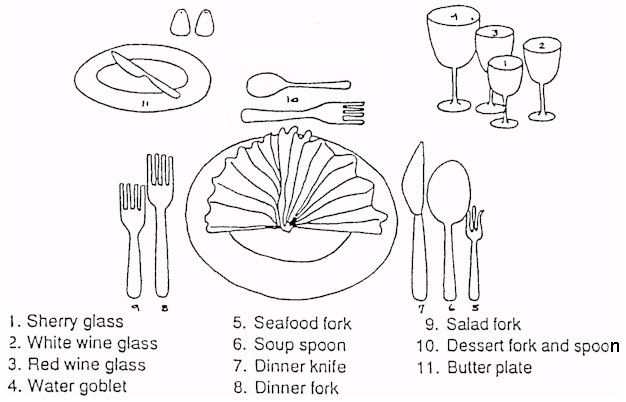It's time to start thinking about placesettings with Christmas dinner just days away. So, consider this as a public service announcement. Before your in-laws arrive for the holidays, it might be good to have a refresher course on where the salad fork goes and which glassware to use. Let's stave off embarrasement and confirm which butter plate is ours so we don't eat the dinner roll meant for the guest seated in the next chair!
FORMAL TABLESETTING
The silverware used at a formal table setting should be sterling silver flatware. It is not necessary that all the sterling silver match, although I like to have forks match and knives and spoons match. Dessert sterling silver flatware, which can be set at the table or brought in with the desert plates, need not match the dinner flatware.Didn't inherit grandmother's silver service or planning a less formal tablescape? Not to worry. In this day and age, stainless steel will do just fine. But, whatever you use make sure it's the best you have for festive occasions and polished to a blinding shine.
INDIVIDUAL PLACE SETTINGS
Give your guest ample elbow room. About two feet from plate center to plate center is ideal. If the chairs have narrow and low backs, people can sit a bit closer together. I'm a big fan of chargers, so those always are first put around the table at equal distances and set with dinner plates. Next, the sterling silver flatware is placed in the order of its use, with the implements to be used first farthest from the plate. The meat fork is placed to the left of the plate, then the salad fork on the outside of the meat fork. Just to the right of the plate is the meat knife with the cutting edge toward the plate. Outside the knife is the soup spoon. If serving seafood, the seafood fork will rest outside on the right of the soup spoon.
If bread or rolls are to be served, a butter plate should be used. The butter plate is located above the forks at the left of the place setting. A butter knife is laid across it, slightly diagonally from upper left to lower right, with the sharper edge of the blade toward the edge of the table.
If you plan to serve coffee with the meal, the cup and saucer go to the right of the setting, with the coffee spoon on the right side of the saucer (not shown in diagram).
The wineglasses chosen for the formal table setting depend upon the menu, but their table setting arrangement is according to size, so that little ones are not hidden behind large ones. Place them directly above the knives in a straight row slanting downward from the upper left. Generally only one - at the most, two - wines are served, so a water goblet and one (or two) wineglasses are all that are necessary. I've never served sherry in my life, so there are never any sherry glasses on my table. Frequently wine is not served at all, and iced-tea glasses or simply tumblers for water or mugs for beer are used.
Let's review what type of glassware is appropriate for the drinks being served.
GLASSWARE
Champagne: a narrow fluted glass, which reduces the wine’s surface area and keep the bubbles from dissipating.
Brandy: brandy snifter. Roll the snifter between both hands and then cup it in one hand – warming the glass brings out the bouquet in brandy.
White wine: slightly smaller glass with wider bowl to capture the bouquet. Hold the glass by the stem to preserve its chill.
Red wine: the bigger of the wine glasses. Hold the glass at the bottom of the bowl where it meets the stem.
Burgundy Reds and Pinot Noirs: a wide bowl to bring out their complexity. The glass is slightly taller than the white wine glass.


0 comments:
Post a Comment